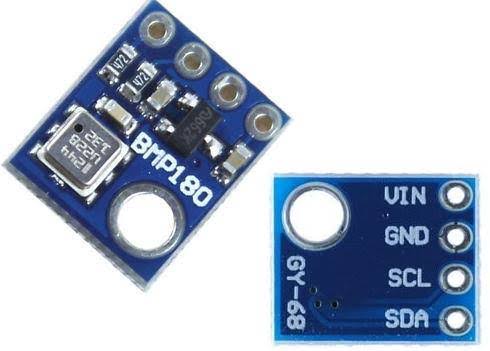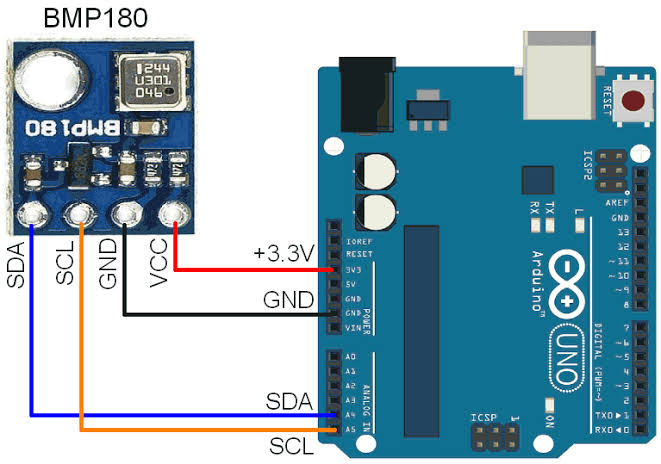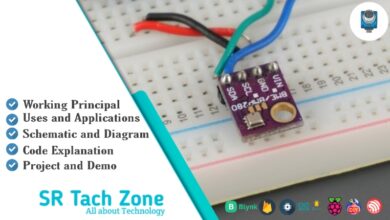What is BMP180 Sensor? & How does it’s work ?

Welcome, Developers & Engineers! We’re excited to have you here. This space is built for creators, problem-solvers, and tech enthusiasts like you. Whether you’re exploring projects or diving into code, you’ve just visited a site that speaks your language. In this blog, you will gain insightful knowledge of the BMP180 Sensor. Basics of the BMP180 Sensor can greatly enhance your projects and applications. So, let’s start.
What is BMP180 Sensor?

The BMP180 is a high-precision digital pressure and temperature sensor developed by Bosch. It’s commonly used in weather monitoring, altitude measurement, and environmental sensing applications. The sensor uses I²C communication, making it easy to interface with microcontrollers like Arduino, Raspberry Pi, or ESP32. It can measure barometric pressure and estimate altitude based on the changes in atmospheric pressure.
Working Principles of BMP180 Sensor
Pressure Measurement
The BMP180 uses a piezo-resistive pressure sensor to measure atmospheric pressure. When air pressure changes, the diaphragm inside the sensor deforms slightly, causing a change in resistance. This resistance change is processed by the sensor’s internal ADC (Analog to Digital Converter) and microcontroller to provide a calibrated pressure reading. The pressure range typically lies between 300 hPa to 1100 hPa with an accuracy of ±1 hPa.
Temperature Measurement
The sensor also includes a built-in temperature sensor to compensate for temperature variations that affect pressure readings. It uses a semiconductor temperature sensor with high accuracy (±1°C). The temperature reading is also accessible directly via the I²C interface.
Digital Communication
The BMP180 communicates with microcontrollers using the I²C (Inter-Integrated Circuit) protocol. It requires only two lines: SCL (Clock) and SDA (Data). Each reading involves sending a command to the sensor and then reading the resulting data bytes. The sensor automatically handles calibration internally using factory-stored coefficients for accurate results.
Hardware Overview of BMP180 Sensor
The BMP180 is a compact, low-power sensor module with onboard signal conditioning and digital output. It typically comes on a breakout board with four pins (VCC, GND, SDA, SCL) for easy connection.

The sensor’s main chip contains a pressure-sensing diaphragm, temperature sensor, and a 16-bit ADC controlled by an internal microcontroller. The module can operate at both 3.3V and 5V depending on the version.
Supporting Circuitry
When connecting BMP180 to microcontrollers:
- VCC: Connect to 3.3V or 5V (depending on board support)
- GND: Connect to ground
- SDA: Connect to the I²C data pin
- SCL: Connect to the I²C clock pin
The sensor usually includes onboard pull-up resistors for SDA and SCL, but if you’re using multiple I²C devices, ensure only one pair of pull-ups (typically 4.7kΩ) is active.
Technical Specifications of BMP180 Sensor
- Function: Measures barometric pressure and temperature.
- Output: Digital (I²C communication).
- Pressure Range: 300 hPa to 1100 hPa (equivalent to altitudes -500m to +9000m).
- Pressure Accuracy: ±1 hPa.
- Temperature Range: 0°C to 65°C.
- Temperature Accuracy: ±1°C.
- Supply Voltage: 1.8V to 3.6V (3.3V typical).
- Current Consumption: 3 µA (typical during measurement).
- Interface: I²C (7-bit address 0x77).
- Resolution: 0.01 hPa (0.1m altitude resolution).
BMP180 Sensor Pinout

- VCC: Power supply (3.3V – 5V)
- GND: Ground
- SDA: I²C Data Line
- SCL: I²C Clock Line
Real Life Uses and Applications of BMP180 Sensor
- Weather Stations: Measure barometric pressure, temperature, and estimate altitude for local weather prediction.
- Altimeters: Used in drones, airplanes, or wearable devices for altitude detection.
- GPS Correction: Enhances GPS accuracy by providing real-time pressure-based altitude data.
- Indoor Navigation: Helps determine floor levels in multi-story buildings.
- Smart Home Automation: Used in environmental monitoring systems for room air quality tracking.
- IoT Weather Nodes: Part of remote IoT weather sensing units for environmental analysis.
Using BMP180 Sensor with Arduino
Let’s learn how to use the BMP180 sensor with Arduino Uno, Nano, or Mega to read temperature and pressure data in just a few minutes.
What You Need
- Any Arduino board (Uno, Nano, Mega, or compatible)
- BMP180 sensor module
- Jumper wires
Wiring Diagram

- VCC → 3.3V or 5V
- GND → GND
- SDA → A4 (Arduino Uno)
- SCL → A5 (Arduino Uno)
Code
Install the “Adafruit BMP085 Unified” or “Adafruit BMP180 Library” before uploading the code. Then copy and paste the following code into your Arduino IDE:
#include <Wire.h>
#include <Adafruit_BMP085.h>
Adafruit_BMP085 bmp;
void setup() {
Serial.begin(9600);
if (!bmp.begin()) {
Serial.println("Could not find BMP180 sensor!");
while (1) {}
}
Serial.println("BMP180 Sensor is ready!");
}
void loop() {
Serial.print("Temperature: ");
Serial.print(bmp.readTemperature());
Serial.println(" °C");
Serial.print("Pressure: ");
Serial.print(bmp.readPressure() / 100.0);
Serial.println(" hPa");
Serial.print("Approx Altitude: ");
Serial.print(bmp.readAltitude());
Serial.println(" meters");
Serial.println("--------------------");
delay(2000);
}
After uploading, open the Serial Monitor (Ctrl+Shift+M), set the baud rate to 9600, and you’ll see live readings of temperature, pressure, and estimated altitude every 2 seconds.
Wrapping Up
In this post, we’ve covered all the essential details of the BMP180 Sensor — from working principles and specifications to practical applications and Arduino integration. We hope this article helps you confidently use the BMP180 in your projects. If you have any questions, feel free to ask in the comments section below we’re here to help!



